Empirical Investigation of Risk Management Framework in Islamic Banks
VerifiedAdded on 2023/01/06
|69
|18233
|2
Report
AI Summary
This report provides a comprehensive literature review on the risk management framework of Islamic banks, with a specific focus on the context of Pakistan. It begins by defining risk management and its importance in the banking sector, highlighting the unique aspects of Islamic banking and its risk profile. The review covers various types of risks faced by Islamic banks, including credit risk, market risk, liquidity risk, and operational risk, discussing their origins, potential impacts, and management strategies. The report emphasizes the differences between theoretical formulations and practical applications in Islamic banking, addressing challenges such as credit risk arising from profit-sharing agreements, market risks stemming from macroeconomic factors, and liquidity risks due to the nature of Islamic financial instruments. It also explores the components of an effective risk management framework, including risk identification, measurement, mitigation, reporting, and monitoring, and discusses the importance of risk governance. The report concludes by analyzing the characteristics of risks faced by Islamic banks and the methods used to manage them, offering insights into the evolution of risk management practices in the Islamic banking sector.
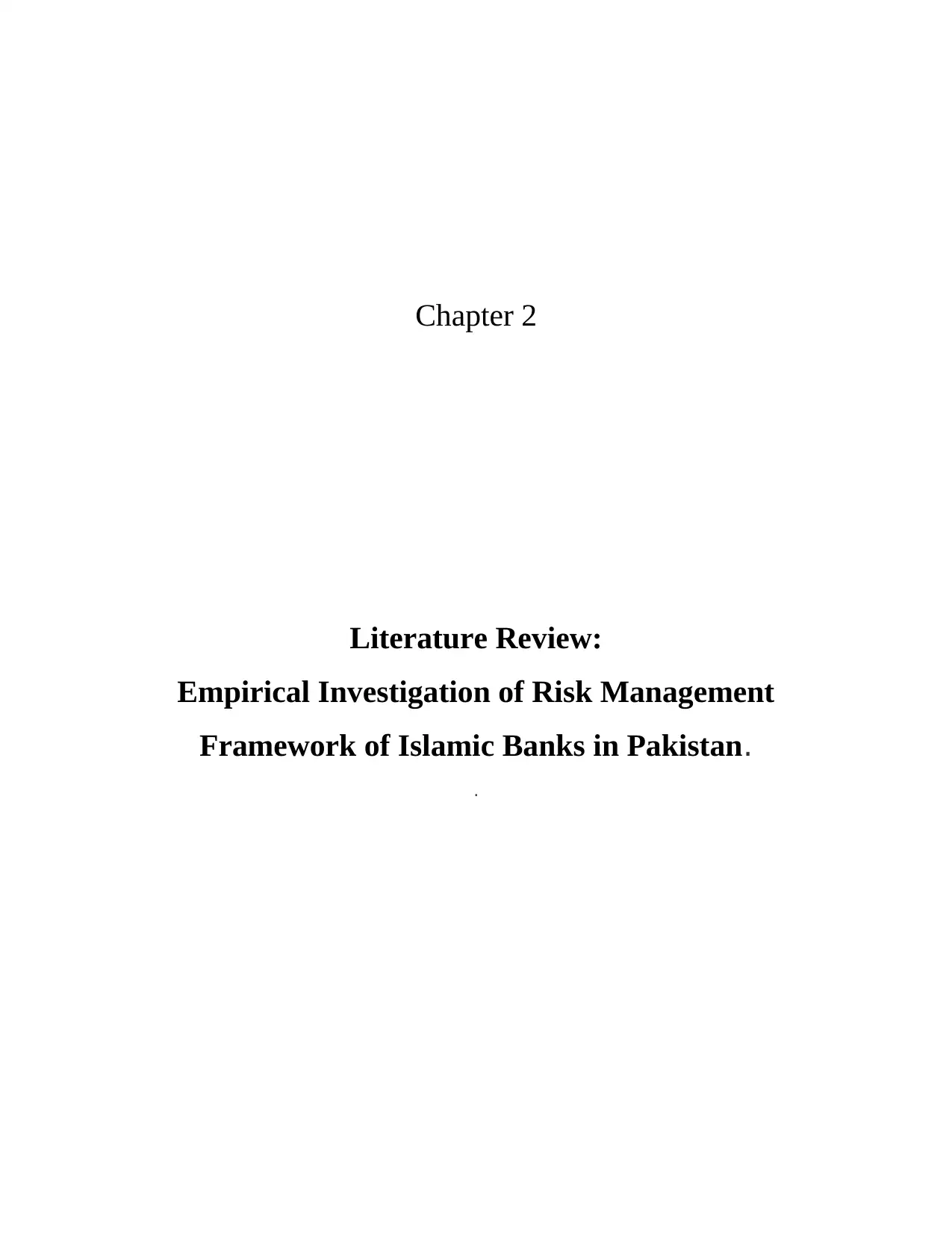
Chapter 2
Literature Review:
Empirical Investigation of Risk Management
Framework of Islamic Banks in Pakistan.
.
Literature Review:
Empirical Investigation of Risk Management
Framework of Islamic Banks in Pakistan.
.
Paraphrase This Document
Need a fresh take? Get an instant paraphrase of this document with our AI Paraphraser
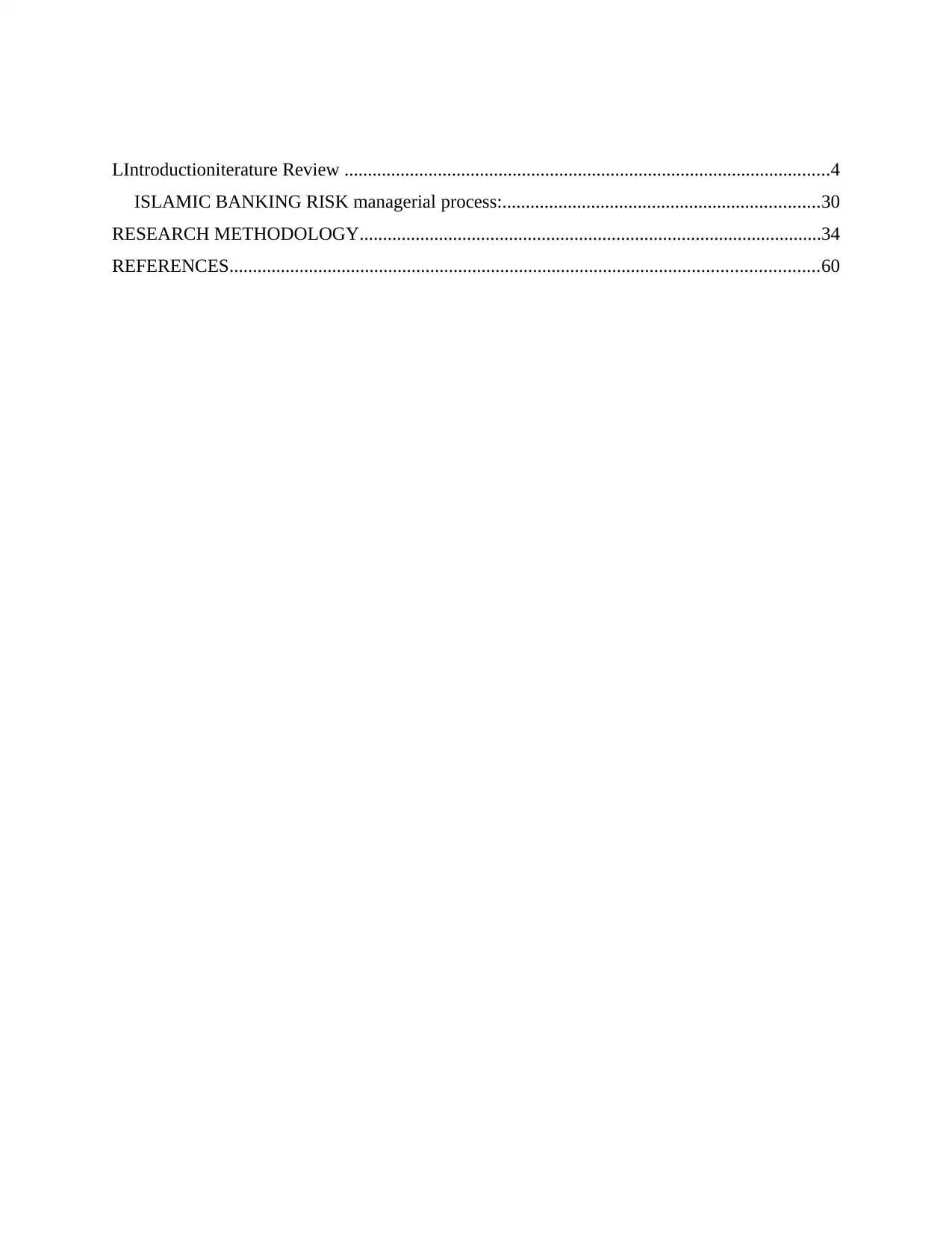
LIntroductioniterature Review ........................................................................................................4
ISLAMIC BANKING RISK managerial process:....................................................................30
RESEARCH METHODOLOGY...................................................................................................34
REFERENCES..............................................................................................................................60
ISLAMIC BANKING RISK managerial process:....................................................................30
RESEARCH METHODOLOGY...................................................................................................34
REFERENCES..............................................................................................................................60
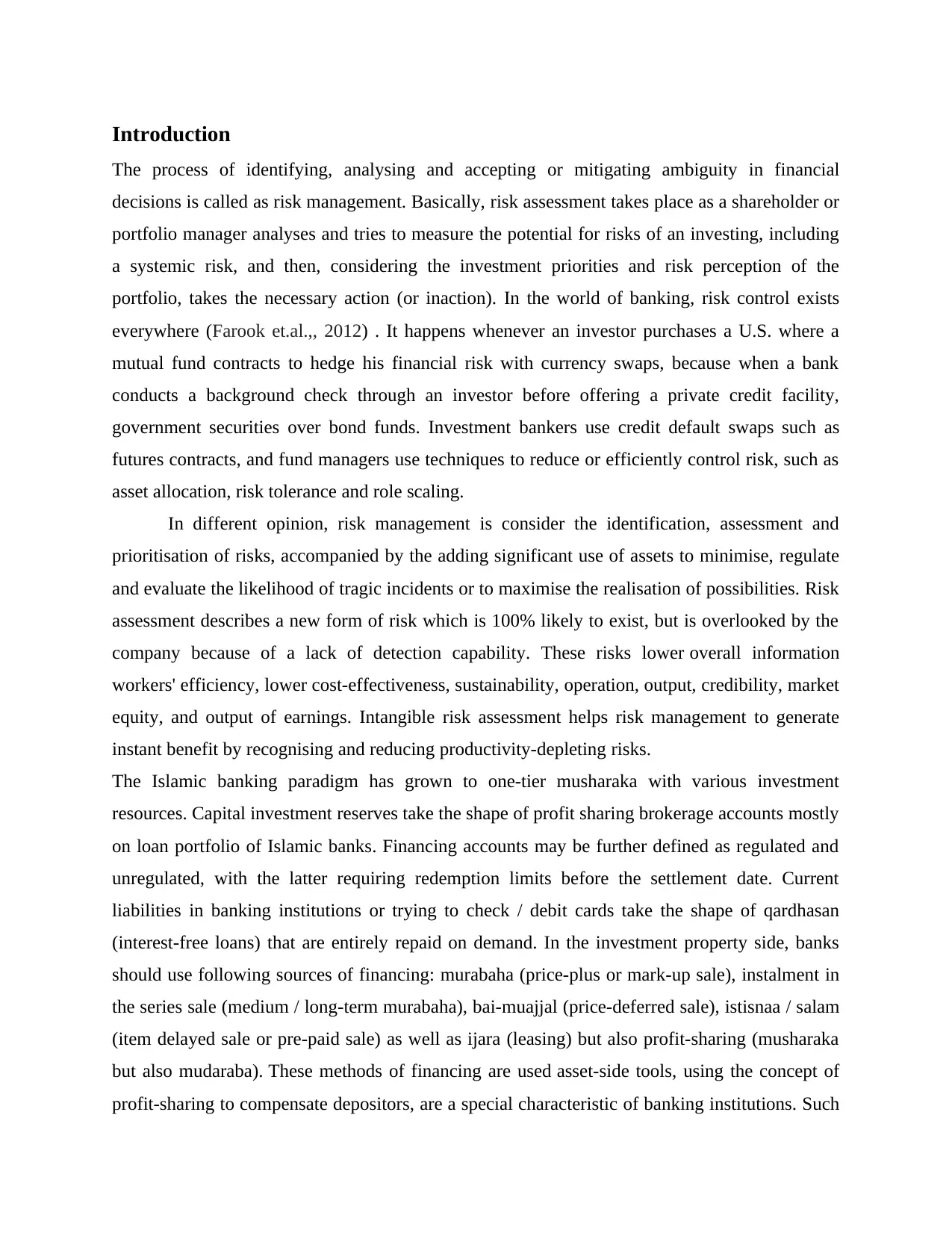
Introduction
The process of identifying, analysing and accepting or mitigating ambiguity in financial
decisions is called as risk management. Basically, risk assessment takes place as a shareholder or
portfolio manager analyses and tries to measure the potential for risks of an investing, including
a systemic risk, and then, considering the investment priorities and risk perception of the
portfolio, takes the necessary action (or inaction). In the world of banking, risk control exists
everywhere (Farook et.al.,, 2012) . It happens whenever an investor purchases a U.S. where a
mutual fund contracts to hedge his financial risk with currency swaps, because when a bank
conducts a background check through an investor before offering a private credit facility,
government securities over bond funds. Investment bankers use credit default swaps such as
futures contracts, and fund managers use techniques to reduce or efficiently control risk, such as
asset allocation, risk tolerance and role scaling.
In different opinion, risk management is consider the identification, assessment and
prioritisation of risks, accompanied by the adding significant use of assets to minimise, regulate
and evaluate the likelihood of tragic incidents or to maximise the realisation of possibilities. Risk
assessment describes a new form of risk which is 100% likely to exist, but is overlooked by the
company because of a lack of detection capability. These risks lower overall information
workers' efficiency, lower cost-effectiveness, sustainability, operation, output, credibility, market
equity, and output of earnings. Intangible risk assessment helps risk management to generate
instant benefit by recognising and reducing productivity-depleting risks.
The Islamic banking paradigm has grown to one-tier musharaka with various investment
resources. Capital investment reserves take the shape of profit sharing brokerage accounts mostly
on loan portfolio of Islamic banks. Financing accounts may be further defined as regulated and
unregulated, with the latter requiring redemption limits before the settlement date. Current
liabilities in banking institutions or trying to check / debit cards take the shape of qardhasan
(interest-free loans) that are entirely repaid on demand. In the investment property side, banks
should use following sources of financing: murabaha (price-plus or mark-up sale), instalment in
the series sale (medium / long-term murabaha), bai-muajjal (price-deferred sale), istisnaa / salam
(item delayed sale or pre-paid sale) as well as ijara (leasing) but also profit-sharing (musharaka
but also mudaraba). These methods of financing are used asset-side tools, using the concept of
profit-sharing to compensate depositors, are a special characteristic of banking institutions. Such
The process of identifying, analysing and accepting or mitigating ambiguity in financial
decisions is called as risk management. Basically, risk assessment takes place as a shareholder or
portfolio manager analyses and tries to measure the potential for risks of an investing, including
a systemic risk, and then, considering the investment priorities and risk perception of the
portfolio, takes the necessary action (or inaction). In the world of banking, risk control exists
everywhere (Farook et.al.,, 2012) . It happens whenever an investor purchases a U.S. where a
mutual fund contracts to hedge his financial risk with currency swaps, because when a bank
conducts a background check through an investor before offering a private credit facility,
government securities over bond funds. Investment bankers use credit default swaps such as
futures contracts, and fund managers use techniques to reduce or efficiently control risk, such as
asset allocation, risk tolerance and role scaling.
In different opinion, risk management is consider the identification, assessment and
prioritisation of risks, accompanied by the adding significant use of assets to minimise, regulate
and evaluate the likelihood of tragic incidents or to maximise the realisation of possibilities. Risk
assessment describes a new form of risk which is 100% likely to exist, but is overlooked by the
company because of a lack of detection capability. These risks lower overall information
workers' efficiency, lower cost-effectiveness, sustainability, operation, output, credibility, market
equity, and output of earnings. Intangible risk assessment helps risk management to generate
instant benefit by recognising and reducing productivity-depleting risks.
The Islamic banking paradigm has grown to one-tier musharaka with various investment
resources. Capital investment reserves take the shape of profit sharing brokerage accounts mostly
on loan portfolio of Islamic banks. Financing accounts may be further defined as regulated and
unregulated, with the latter requiring redemption limits before the settlement date. Current
liabilities in banking institutions or trying to check / debit cards take the shape of qardhasan
(interest-free loans) that are entirely repaid on demand. In the investment property side, banks
should use following sources of financing: murabaha (price-plus or mark-up sale), instalment in
the series sale (medium / long-term murabaha), bai-muajjal (price-deferred sale), istisnaa / salam
(item delayed sale or pre-paid sale) as well as ijara (leasing) but also profit-sharing (musharaka
but also mudaraba). These methods of financing are used asset-side tools, using the concept of
profit-sharing to compensate depositors, are a special characteristic of banking institutions. Such
⊘ This is a preview!⊘
Do you want full access?
Subscribe today to unlock all pages.

Trusted by 1+ million students worldwide
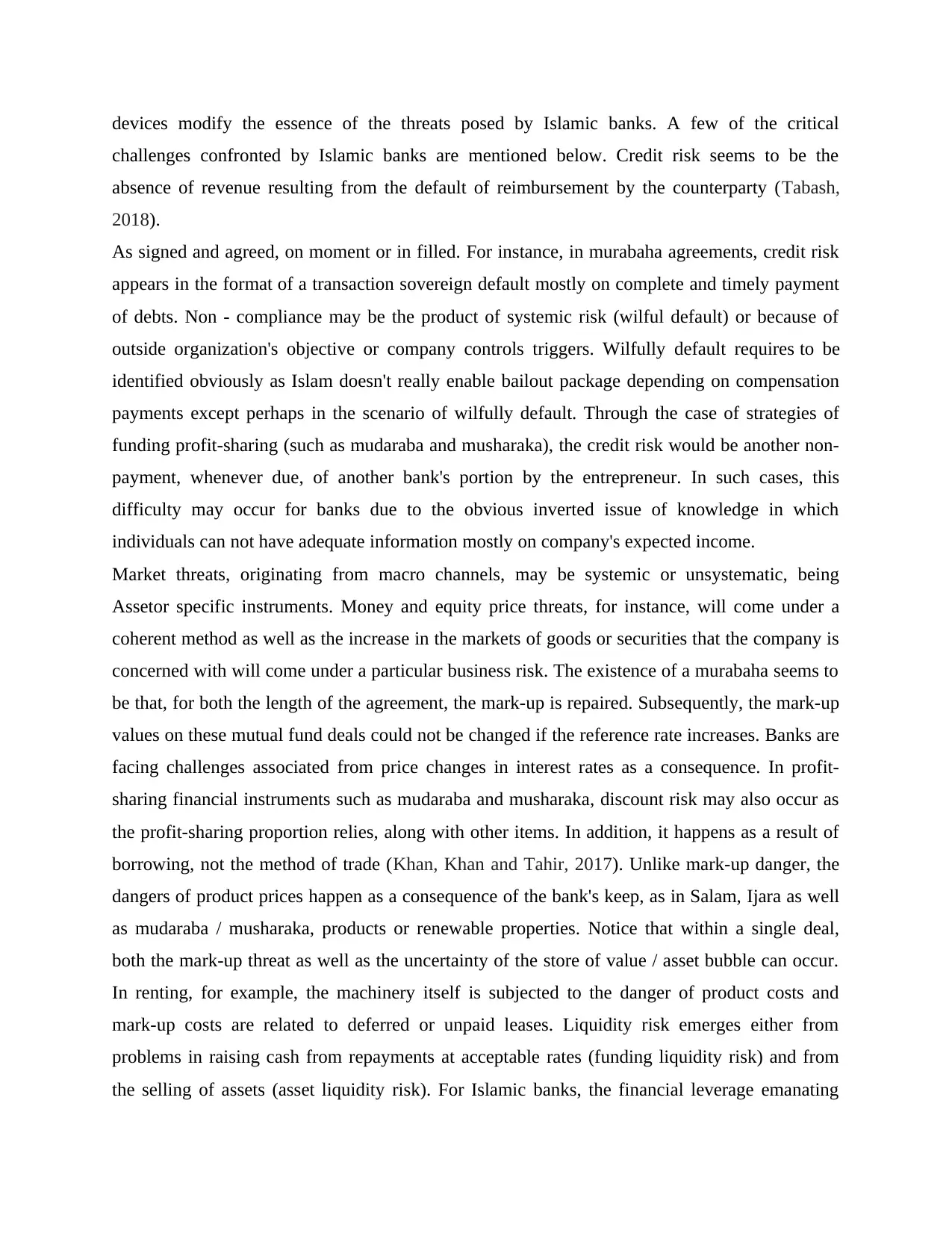
devices modify the essence of the threats posed by Islamic banks. A few of the critical
challenges confronted by Islamic banks are mentioned below. Credit risk seems to be the
absence of revenue resulting from the default of reimbursement by the counterparty (Tabash,
2018).
As signed and agreed, on moment or in filled. For instance, in murabaha agreements, credit risk
appears in the format of a transaction sovereign default mostly on complete and timely payment
of debts. Non - compliance may be the product of systemic risk (wilful default) or because of
outside organization's objective or company controls triggers. Wilfully default requires to be
identified obviously as Islam doesn't really enable bailout package depending on compensation
payments except perhaps in the scenario of wilfully default. Through the case of strategies of
funding profit-sharing (such as mudaraba and musharaka), the credit risk would be another non-
payment, whenever due, of another bank's portion by the entrepreneur. In such cases, this
difficulty may occur for banks due to the obvious inverted issue of knowledge in which
individuals can not have adequate information mostly on company's expected income.
Market threats, originating from macro channels, may be systemic or unsystematic, being
Assetor specific instruments. Money and equity price threats, for instance, will come under a
coherent method as well as the increase in the markets of goods or securities that the company is
concerned with will come under a particular business risk. The existence of a murabaha seems to
be that, for both the length of the agreement, the mark-up is repaired. Subsequently, the mark-up
values on these mutual fund deals could not be changed if the reference rate increases. Banks are
facing challenges associated from price changes in interest rates as a consequence. In profit-
sharing financial instruments such as mudaraba and musharaka, discount risk may also occur as
the profit-sharing proportion relies, along with other items. In addition, it happens as a result of
borrowing, not the method of trade (Khan, Khan and Tahir, 2017). Unlike mark-up danger, the
dangers of product prices happen as a consequence of the bank's keep, as in Salam, Ijara as well
as mudaraba / musharaka, products or renewable properties. Notice that within a single deal,
both the mark-up threat as well as the uncertainty of the store of value / asset bubble can occur.
In renting, for example, the machinery itself is subjected to the danger of product costs and
mark-up costs are related to deferred or unpaid leases. Liquidity risk emerges either from
problems in raising cash from repayments at acceptable rates (funding liquidity risk) and from
the selling of assets (asset liquidity risk). For Islamic banks, the financial leverage emanating
challenges confronted by Islamic banks are mentioned below. Credit risk seems to be the
absence of revenue resulting from the default of reimbursement by the counterparty (Tabash,
2018).
As signed and agreed, on moment or in filled. For instance, in murabaha agreements, credit risk
appears in the format of a transaction sovereign default mostly on complete and timely payment
of debts. Non - compliance may be the product of systemic risk (wilful default) or because of
outside organization's objective or company controls triggers. Wilfully default requires to be
identified obviously as Islam doesn't really enable bailout package depending on compensation
payments except perhaps in the scenario of wilfully default. Through the case of strategies of
funding profit-sharing (such as mudaraba and musharaka), the credit risk would be another non-
payment, whenever due, of another bank's portion by the entrepreneur. In such cases, this
difficulty may occur for banks due to the obvious inverted issue of knowledge in which
individuals can not have adequate information mostly on company's expected income.
Market threats, originating from macro channels, may be systemic or unsystematic, being
Assetor specific instruments. Money and equity price threats, for instance, will come under a
coherent method as well as the increase in the markets of goods or securities that the company is
concerned with will come under a particular business risk. The existence of a murabaha seems to
be that, for both the length of the agreement, the mark-up is repaired. Subsequently, the mark-up
values on these mutual fund deals could not be changed if the reference rate increases. Banks are
facing challenges associated from price changes in interest rates as a consequence. In profit-
sharing financial instruments such as mudaraba and musharaka, discount risk may also occur as
the profit-sharing proportion relies, along with other items. In addition, it happens as a result of
borrowing, not the method of trade (Khan, Khan and Tahir, 2017). Unlike mark-up danger, the
dangers of product prices happen as a consequence of the bank's keep, as in Salam, Ijara as well
as mudaraba / musharaka, products or renewable properties. Notice that within a single deal,
both the mark-up threat as well as the uncertainty of the store of value / asset bubble can occur.
In renting, for example, the machinery itself is subjected to the danger of product costs and
mark-up costs are related to deferred or unpaid leases. Liquidity risk emerges either from
problems in raising cash from repayments at acceptable rates (funding liquidity risk) and from
the selling of assets (asset liquidity risk). For Islamic banks, the financial leverage emanating
Paraphrase This Document
Need a fresh take? Get an instant paraphrase of this document with our AI Paraphraser
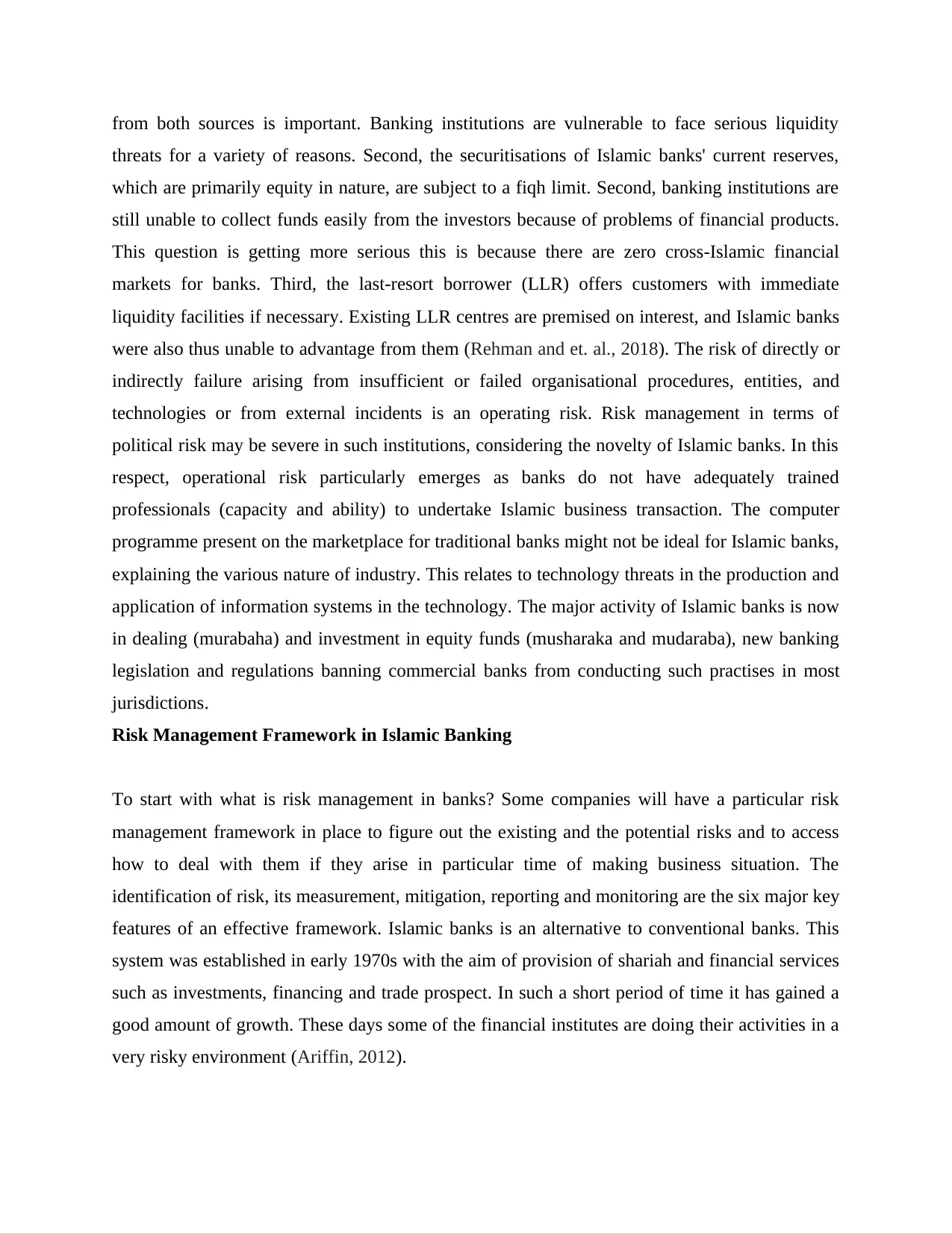
from both sources is important. Banking institutions are vulnerable to face serious liquidity
threats for a variety of reasons. Second, the securitisations of Islamic banks' current reserves,
which are primarily equity in nature, are subject to a fiqh limit. Second, banking institutions are
still unable to collect funds easily from the investors because of problems of financial products.
This question is getting more serious this is because there are zero cross-Islamic financial
markets for banks. Third, the last-resort borrower (LLR) offers customers with immediate
liquidity facilities if necessary. Existing LLR centres are premised on interest, and Islamic banks
were also thus unable to advantage from them (Rehman and et. al., 2018). The risk of directly or
indirectly failure arising from insufficient or failed organisational procedures, entities, and
technologies or from external incidents is an operating risk. Risk management in terms of
political risk may be severe in such institutions, considering the novelty of Islamic banks. In this
respect, operational risk particularly emerges as banks do not have adequately trained
professionals (capacity and ability) to undertake Islamic business transaction. The computer
programme present on the marketplace for traditional banks might not be ideal for Islamic banks,
explaining the various nature of industry. This relates to technology threats in the production and
application of information systems in the technology. The major activity of Islamic banks is now
in dealing (murabaha) and investment in equity funds (musharaka and mudaraba), new banking
legislation and regulations banning commercial banks from conducting such practises in most
jurisdictions.
Risk Management Framework in Islamic Banking
To start with what is risk management in banks? Some companies will have a particular risk
management framework in place to figure out the existing and the potential risks and to access
how to deal with them if they arise in particular time of making business situation. The
identification of risk, its measurement, mitigation, reporting and monitoring are the six major key
features of an effective framework. Islamic banks is an alternative to conventional banks. This
system was established in early 1970s with the aim of provision of shariah and financial services
such as investments, financing and trade prospect. In such a short period of time it has gained a
good amount of growth. These days some of the financial institutes are doing their activities in a
very risky environment (Ariffin, 2012).
threats for a variety of reasons. Second, the securitisations of Islamic banks' current reserves,
which are primarily equity in nature, are subject to a fiqh limit. Second, banking institutions are
still unable to collect funds easily from the investors because of problems of financial products.
This question is getting more serious this is because there are zero cross-Islamic financial
markets for banks. Third, the last-resort borrower (LLR) offers customers with immediate
liquidity facilities if necessary. Existing LLR centres are premised on interest, and Islamic banks
were also thus unable to advantage from them (Rehman and et. al., 2018). The risk of directly or
indirectly failure arising from insufficient or failed organisational procedures, entities, and
technologies or from external incidents is an operating risk. Risk management in terms of
political risk may be severe in such institutions, considering the novelty of Islamic banks. In this
respect, operational risk particularly emerges as banks do not have adequately trained
professionals (capacity and ability) to undertake Islamic business transaction. The computer
programme present on the marketplace for traditional banks might not be ideal for Islamic banks,
explaining the various nature of industry. This relates to technology threats in the production and
application of information systems in the technology. The major activity of Islamic banks is now
in dealing (murabaha) and investment in equity funds (musharaka and mudaraba), new banking
legislation and regulations banning commercial banks from conducting such practises in most
jurisdictions.
Risk Management Framework in Islamic Banking
To start with what is risk management in banks? Some companies will have a particular risk
management framework in place to figure out the existing and the potential risks and to access
how to deal with them if they arise in particular time of making business situation. The
identification of risk, its measurement, mitigation, reporting and monitoring are the six major key
features of an effective framework. Islamic banks is an alternative to conventional banks. This
system was established in early 1970s with the aim of provision of shariah and financial services
such as investments, financing and trade prospect. In such a short period of time it has gained a
good amount of growth. These days some of the financial institutes are doing their activities in a
very risky environment (Ariffin, 2012).
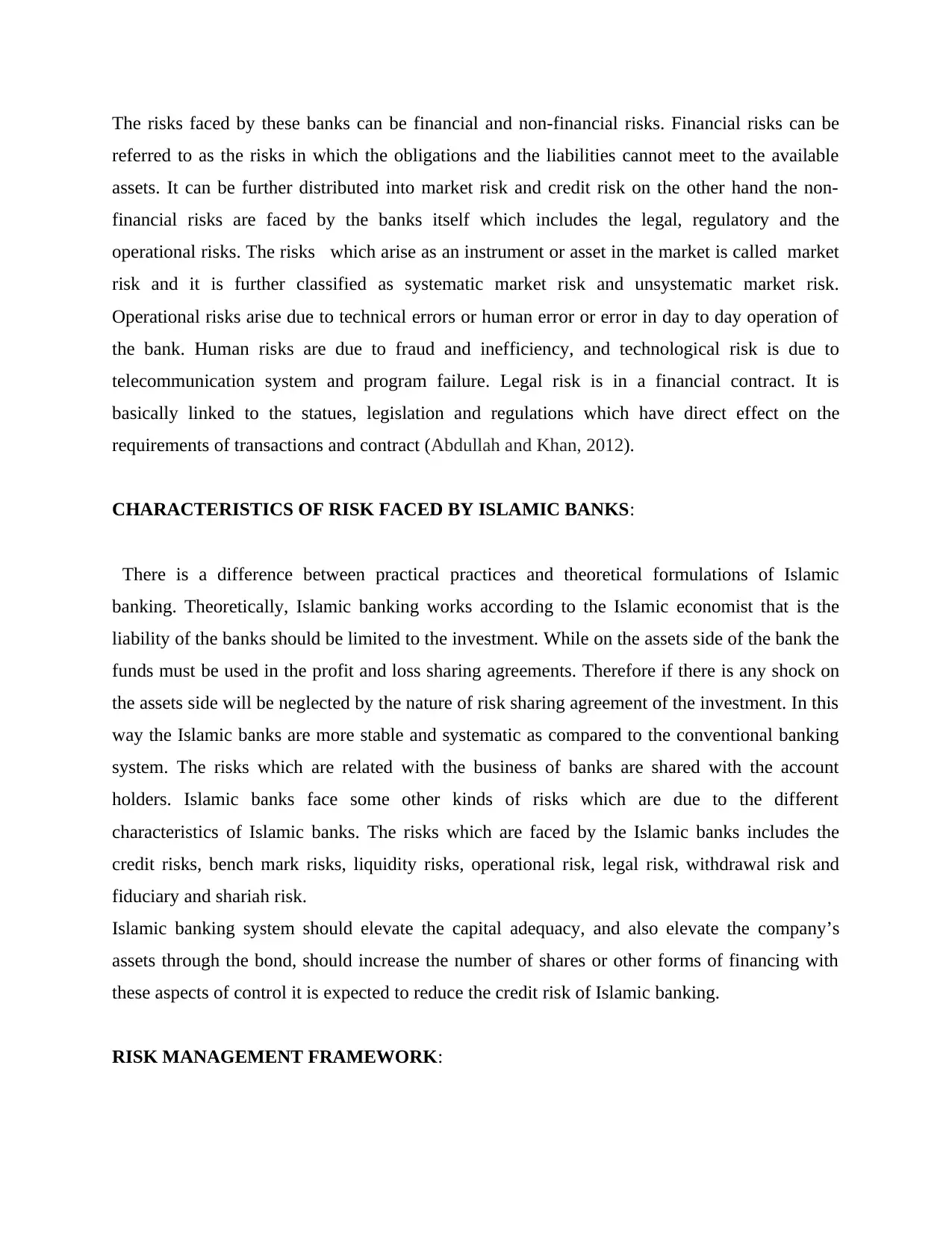
The risks faced by these banks can be financial and non-financial risks. Financial risks can be
referred to as the risks in which the obligations and the liabilities cannot meet to the available
assets. It can be further distributed into market risk and credit risk on the other hand the non-
financial risks are faced by the banks itself which includes the legal, regulatory and the
operational risks. The risks which arise as an instrument or asset in the market is called market
risk and it is further classified as systematic market risk and unsystematic market risk.
Operational risks arise due to technical errors or human error or error in day to day operation of
the bank. Human risks are due to fraud and inefficiency, and technological risk is due to
telecommunication system and program failure. Legal risk is in a financial contract. It is
basically linked to the statues, legislation and regulations which have direct effect on the
requirements of transactions and contract (Abdullah and Khan, 2012).
CHARACTERISTICS OF RISK FACED BY ISLAMIC BANKS:
There is a difference between practical practices and theoretical formulations of Islamic
banking. Theoretically, Islamic banking works according to the Islamic economist that is the
liability of the banks should be limited to the investment. While on the assets side of the bank the
funds must be used in the profit and loss sharing agreements. Therefore if there is any shock on
the assets side will be neglected by the nature of risk sharing agreement of the investment. In this
way the Islamic banks are more stable and systematic as compared to the conventional banking
system. The risks which are related with the business of banks are shared with the account
holders. Islamic banks face some other kinds of risks which are due to the different
characteristics of Islamic banks. The risks which are faced by the Islamic banks includes the
credit risks, bench mark risks, liquidity risks, operational risk, legal risk, withdrawal risk and
fiduciary and shariah risk.
Islamic banking system should elevate the capital adequacy, and also elevate the company’s
assets through the bond, should increase the number of shares or other forms of financing with
these aspects of control it is expected to reduce the credit risk of Islamic banking.
RISK MANAGEMENT FRAMEWORK:
referred to as the risks in which the obligations and the liabilities cannot meet to the available
assets. It can be further distributed into market risk and credit risk on the other hand the non-
financial risks are faced by the banks itself which includes the legal, regulatory and the
operational risks. The risks which arise as an instrument or asset in the market is called market
risk and it is further classified as systematic market risk and unsystematic market risk.
Operational risks arise due to technical errors or human error or error in day to day operation of
the bank. Human risks are due to fraud and inefficiency, and technological risk is due to
telecommunication system and program failure. Legal risk is in a financial contract. It is
basically linked to the statues, legislation and regulations which have direct effect on the
requirements of transactions and contract (Abdullah and Khan, 2012).
CHARACTERISTICS OF RISK FACED BY ISLAMIC BANKS:
There is a difference between practical practices and theoretical formulations of Islamic
banking. Theoretically, Islamic banking works according to the Islamic economist that is the
liability of the banks should be limited to the investment. While on the assets side of the bank the
funds must be used in the profit and loss sharing agreements. Therefore if there is any shock on
the assets side will be neglected by the nature of risk sharing agreement of the investment. In this
way the Islamic banks are more stable and systematic as compared to the conventional banking
system. The risks which are related with the business of banks are shared with the account
holders. Islamic banks face some other kinds of risks which are due to the different
characteristics of Islamic banks. The risks which are faced by the Islamic banks includes the
credit risks, bench mark risks, liquidity risks, operational risk, legal risk, withdrawal risk and
fiduciary and shariah risk.
Islamic banking system should elevate the capital adequacy, and also elevate the company’s
assets through the bond, should increase the number of shares or other forms of financing with
these aspects of control it is expected to reduce the credit risk of Islamic banking.
RISK MANAGEMENT FRAMEWORK:
⊘ This is a preview!⊘
Do you want full access?
Subscribe today to unlock all pages.

Trusted by 1+ million students worldwide
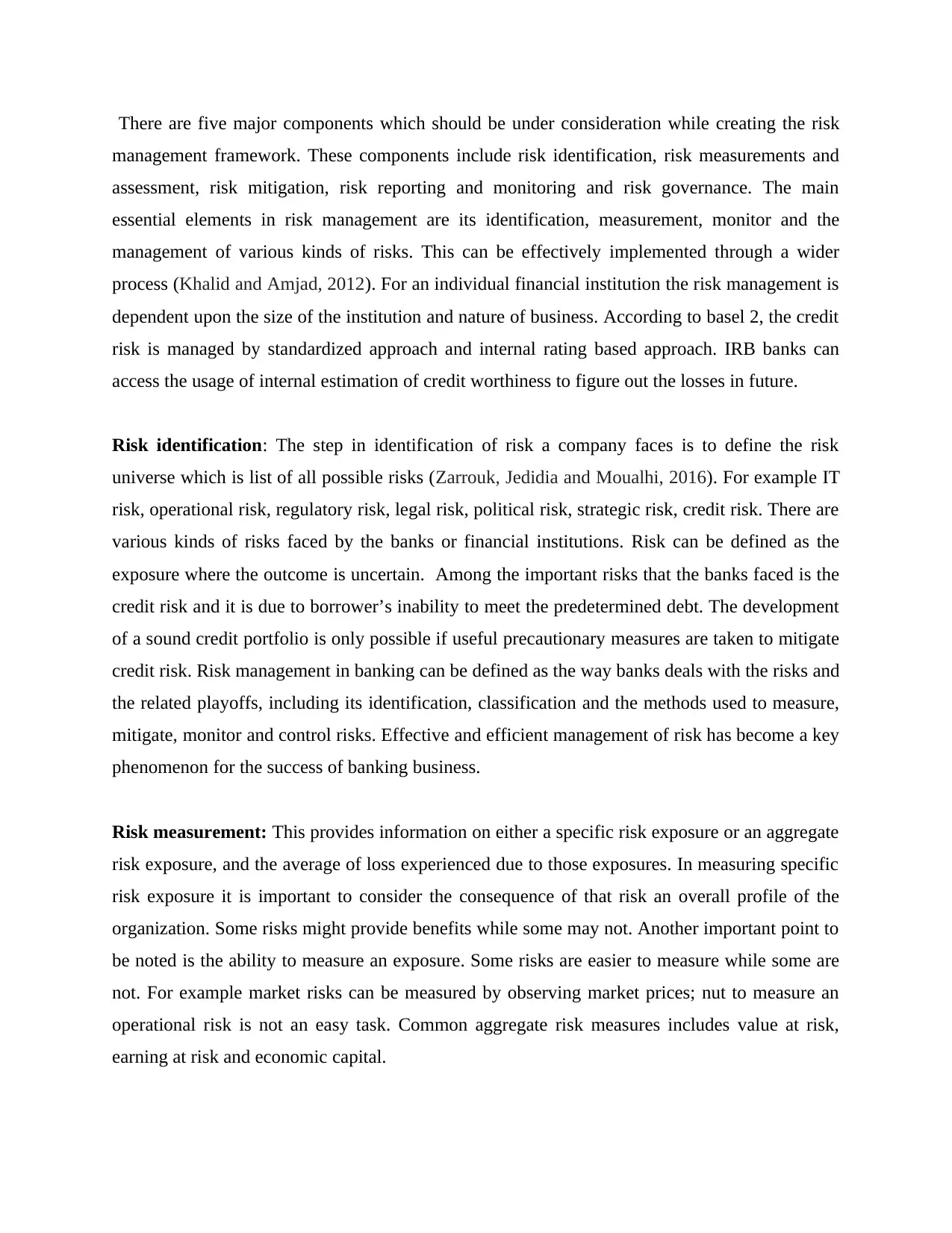
There are five major components which should be under consideration while creating the risk
management framework. These components include risk identification, risk measurements and
assessment, risk mitigation, risk reporting and monitoring and risk governance. The main
essential elements in risk management are its identification, measurement, monitor and the
management of various kinds of risks. This can be effectively implemented through a wider
process (Khalid and Amjad, 2012). For an individual financial institution the risk management is
dependent upon the size of the institution and nature of business. According to basel 2, the credit
risk is managed by standardized approach and internal rating based approach. IRB banks can
access the usage of internal estimation of credit worthiness to figure out the losses in future.
Risk identification: The step in identification of risk a company faces is to define the risk
universe which is list of all possible risks (Zarrouk, Jedidia and Moualhi, 2016). For example IT
risk, operational risk, regulatory risk, legal risk, political risk, strategic risk, credit risk. There are
various kinds of risks faced by the banks or financial institutions. Risk can be defined as the
exposure where the outcome is uncertain. Among the important risks that the banks faced is the
credit risk and it is due to borrower’s inability to meet the predetermined debt. The development
of a sound credit portfolio is only possible if useful precautionary measures are taken to mitigate
credit risk. Risk management in banking can be defined as the way banks deals with the risks and
the related playoffs, including its identification, classification and the methods used to measure,
mitigate, monitor and control risks. Effective and efficient management of risk has become a key
phenomenon for the success of banking business.
Risk measurement: This provides information on either a specific risk exposure or an aggregate
risk exposure, and the average of loss experienced due to those exposures. In measuring specific
risk exposure it is important to consider the consequence of that risk an overall profile of the
organization. Some risks might provide benefits while some may not. Another important point to
be noted is the ability to measure an exposure. Some risks are easier to measure while some are
not. For example market risks can be measured by observing market prices; nut to measure an
operational risk is not an easy task. Common aggregate risk measures includes value at risk,
earning at risk and economic capital.
management framework. These components include risk identification, risk measurements and
assessment, risk mitigation, risk reporting and monitoring and risk governance. The main
essential elements in risk management are its identification, measurement, monitor and the
management of various kinds of risks. This can be effectively implemented through a wider
process (Khalid and Amjad, 2012). For an individual financial institution the risk management is
dependent upon the size of the institution and nature of business. According to basel 2, the credit
risk is managed by standardized approach and internal rating based approach. IRB banks can
access the usage of internal estimation of credit worthiness to figure out the losses in future.
Risk identification: The step in identification of risk a company faces is to define the risk
universe which is list of all possible risks (Zarrouk, Jedidia and Moualhi, 2016). For example IT
risk, operational risk, regulatory risk, legal risk, political risk, strategic risk, credit risk. There are
various kinds of risks faced by the banks or financial institutions. Risk can be defined as the
exposure where the outcome is uncertain. Among the important risks that the banks faced is the
credit risk and it is due to borrower’s inability to meet the predetermined debt. The development
of a sound credit portfolio is only possible if useful precautionary measures are taken to mitigate
credit risk. Risk management in banking can be defined as the way banks deals with the risks and
the related playoffs, including its identification, classification and the methods used to measure,
mitigate, monitor and control risks. Effective and efficient management of risk has become a key
phenomenon for the success of banking business.
Risk measurement: This provides information on either a specific risk exposure or an aggregate
risk exposure, and the average of loss experienced due to those exposures. In measuring specific
risk exposure it is important to consider the consequence of that risk an overall profile of the
organization. Some risks might provide benefits while some may not. Another important point to
be noted is the ability to measure an exposure. Some risks are easier to measure while some are
not. For example market risks can be measured by observing market prices; nut to measure an
operational risk is not an easy task. Common aggregate risk measures includes value at risk,
earning at risk and economic capital.
Paraphrase This Document
Need a fresh take? Get an instant paraphrase of this document with our AI Paraphraser
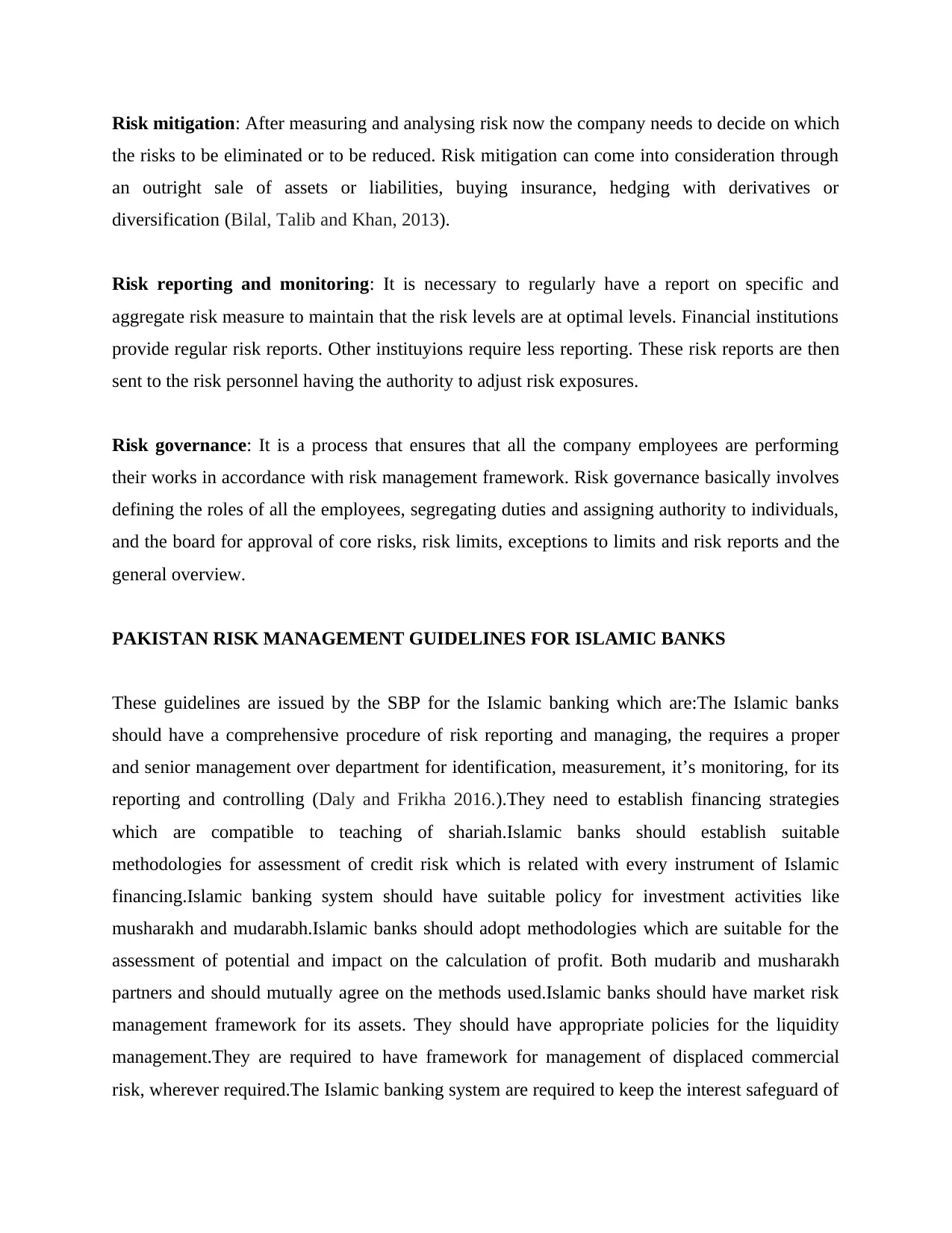
Risk mitigation: After measuring and analysing risk now the company needs to decide on which
the risks to be eliminated or to be reduced. Risk mitigation can come into consideration through
an outright sale of assets or liabilities, buying insurance, hedging with derivatives or
diversification (Bilal, Talib and Khan, 2013).
Risk reporting and monitoring: It is necessary to regularly have a report on specific and
aggregate risk measure to maintain that the risk levels are at optimal levels. Financial institutions
provide regular risk reports. Other instituyions require less reporting. These risk reports are then
sent to the risk personnel having the authority to adjust risk exposures.
Risk governance: It is a process that ensures that all the company employees are performing
their works in accordance with risk management framework. Risk governance basically involves
defining the roles of all the employees, segregating duties and assigning authority to individuals,
and the board for approval of core risks, risk limits, exceptions to limits and risk reports and the
general overview.
PAKISTAN RISK MANAGEMENT GUIDELINES FOR ISLAMIC BANKS
These guidelines are issued by the SBP for the Islamic banking which are:The Islamic banks
should have a comprehensive procedure of risk reporting and managing, the requires a proper
and senior management over department for identification, measurement, it’s monitoring, for its
reporting and controlling (Daly and Frikha 2016.).They need to establish financing strategies
which are compatible to teaching of shariah.Islamic banks should establish suitable
methodologies for assessment of credit risk which is related with every instrument of Islamic
financing.Islamic banking system should have suitable policy for investment activities like
musharakh and mudarabh.Islamic banks should adopt methodologies which are suitable for the
assessment of potential and impact on the calculation of profit. Both mudarib and musharakh
partners and should mutually agree on the methods used.Islamic banks should have market risk
management framework for its assets. They should have appropriate policies for the liquidity
management.They are required to have framework for management of displaced commercial
risk, wherever required.The Islamic banking system are required to keep the interest safeguard of
the risks to be eliminated or to be reduced. Risk mitigation can come into consideration through
an outright sale of assets or liabilities, buying insurance, hedging with derivatives or
diversification (Bilal, Talib and Khan, 2013).
Risk reporting and monitoring: It is necessary to regularly have a report on specific and
aggregate risk measure to maintain that the risk levels are at optimal levels. Financial institutions
provide regular risk reports. Other instituyions require less reporting. These risk reports are then
sent to the risk personnel having the authority to adjust risk exposures.
Risk governance: It is a process that ensures that all the company employees are performing
their works in accordance with risk management framework. Risk governance basically involves
defining the roles of all the employees, segregating duties and assigning authority to individuals,
and the board for approval of core risks, risk limits, exceptions to limits and risk reports and the
general overview.
PAKISTAN RISK MANAGEMENT GUIDELINES FOR ISLAMIC BANKS
These guidelines are issued by the SBP for the Islamic banking which are:The Islamic banks
should have a comprehensive procedure of risk reporting and managing, the requires a proper
and senior management over department for identification, measurement, it’s monitoring, for its
reporting and controlling (Daly and Frikha 2016.).They need to establish financing strategies
which are compatible to teaching of shariah.Islamic banks should establish suitable
methodologies for assessment of credit risk which is related with every instrument of Islamic
financing.Islamic banking system should have suitable policy for investment activities like
musharakh and mudarabh.Islamic banks should adopt methodologies which are suitable for the
assessment of potential and impact on the calculation of profit. Both mudarib and musharakh
partners and should mutually agree on the methods used.Islamic banks should have market risk
management framework for its assets. They should have appropriate policies for the liquidity
management.They are required to have framework for management of displaced commercial
risk, wherever required.The Islamic banking system are required to keep the interest safeguard of
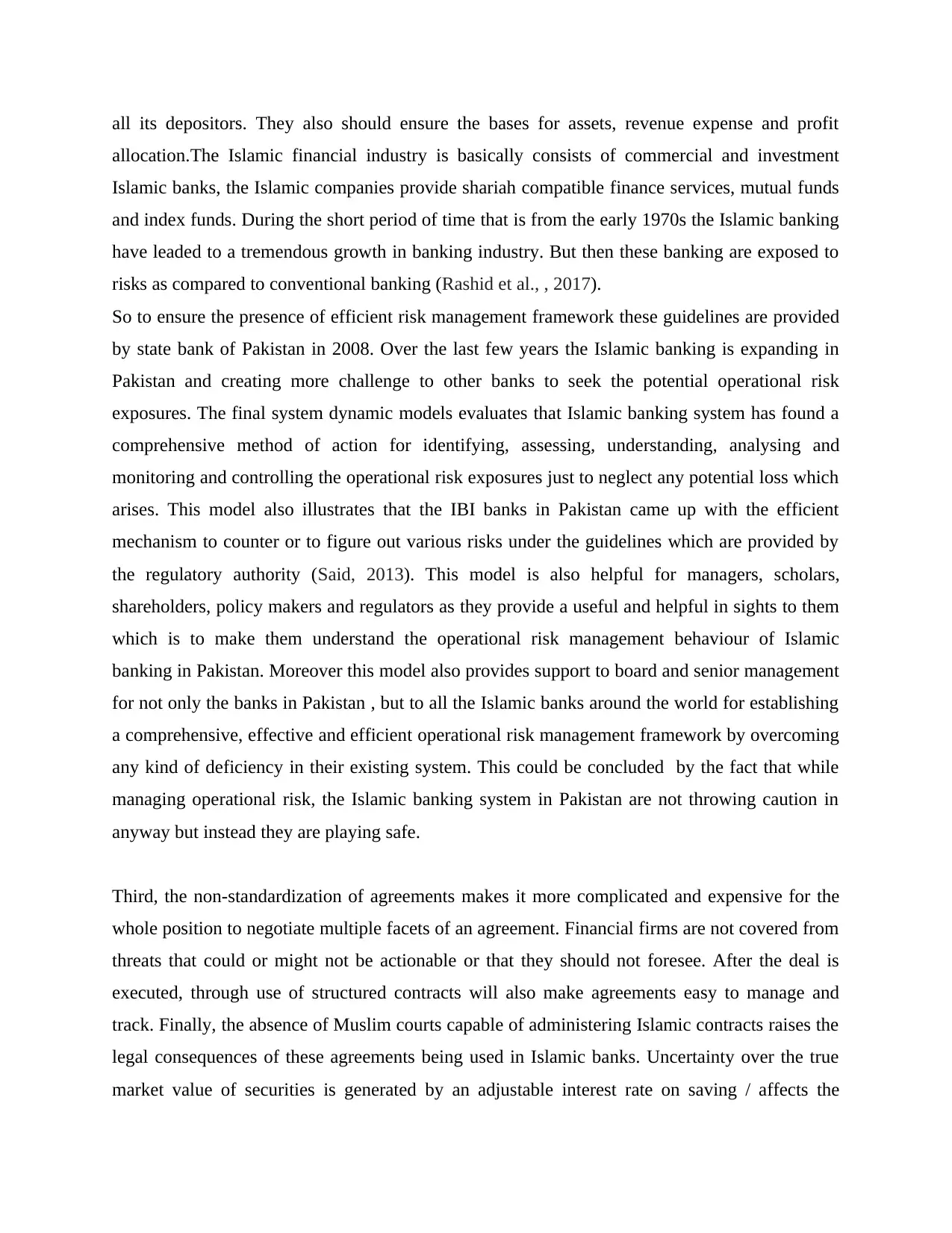
all its depositors. They also should ensure the bases for assets, revenue expense and profit
allocation.The Islamic financial industry is basically consists of commercial and investment
Islamic banks, the Islamic companies provide shariah compatible finance services, mutual funds
and index funds. During the short period of time that is from the early 1970s the Islamic banking
have leaded to a tremendous growth in banking industry. But then these banking are exposed to
risks as compared to conventional banking (Rashid et al., , 2017).
So to ensure the presence of efficient risk management framework these guidelines are provided
by state bank of Pakistan in 2008. Over the last few years the Islamic banking is expanding in
Pakistan and creating more challenge to other banks to seek the potential operational risk
exposures. The final system dynamic models evaluates that Islamic banking system has found a
comprehensive method of action for identifying, assessing, understanding, analysing and
monitoring and controlling the operational risk exposures just to neglect any potential loss which
arises. This model also illustrates that the IBI banks in Pakistan came up with the efficient
mechanism to counter or to figure out various risks under the guidelines which are provided by
the regulatory authority (Said, 2013). This model is also helpful for managers, scholars,
shareholders, policy makers and regulators as they provide a useful and helpful in sights to them
which is to make them understand the operational risk management behaviour of Islamic
banking in Pakistan. Moreover this model also provides support to board and senior management
for not only the banks in Pakistan , but to all the Islamic banks around the world for establishing
a comprehensive, effective and efficient operational risk management framework by overcoming
any kind of deficiency in their existing system. This could be concluded by the fact that while
managing operational risk, the Islamic banking system in Pakistan are not throwing caution in
anyway but instead they are playing safe.
Third, the non-standardization of agreements makes it more complicated and expensive for the
whole position to negotiate multiple facets of an agreement. Financial firms are not covered from
threats that could or might not be actionable or that they should not foresee. After the deal is
executed, through use of structured contracts will also make agreements easy to manage and
track. Finally, the absence of Muslim courts capable of administering Islamic contracts raises the
legal consequences of these agreements being used in Islamic banks. Uncertainty over the true
market value of securities is generated by an adjustable interest rate on saving / affects the
allocation.The Islamic financial industry is basically consists of commercial and investment
Islamic banks, the Islamic companies provide shariah compatible finance services, mutual funds
and index funds. During the short period of time that is from the early 1970s the Islamic banking
have leaded to a tremendous growth in banking industry. But then these banking are exposed to
risks as compared to conventional banking (Rashid et al., , 2017).
So to ensure the presence of efficient risk management framework these guidelines are provided
by state bank of Pakistan in 2008. Over the last few years the Islamic banking is expanding in
Pakistan and creating more challenge to other banks to seek the potential operational risk
exposures. The final system dynamic models evaluates that Islamic banking system has found a
comprehensive method of action for identifying, assessing, understanding, analysing and
monitoring and controlling the operational risk exposures just to neglect any potential loss which
arises. This model also illustrates that the IBI banks in Pakistan came up with the efficient
mechanism to counter or to figure out various risks under the guidelines which are provided by
the regulatory authority (Said, 2013). This model is also helpful for managers, scholars,
shareholders, policy makers and regulators as they provide a useful and helpful in sights to them
which is to make them understand the operational risk management behaviour of Islamic
banking in Pakistan. Moreover this model also provides support to board and senior management
for not only the banks in Pakistan , but to all the Islamic banks around the world for establishing
a comprehensive, effective and efficient operational risk management framework by overcoming
any kind of deficiency in their existing system. This could be concluded by the fact that while
managing operational risk, the Islamic banking system in Pakistan are not throwing caution in
anyway but instead they are playing safe.
Third, the non-standardization of agreements makes it more complicated and expensive for the
whole position to negotiate multiple facets of an agreement. Financial firms are not covered from
threats that could or might not be actionable or that they should not foresee. After the deal is
executed, through use of structured contracts will also make agreements easy to manage and
track. Finally, the absence of Muslim courts capable of administering Islamic contracts raises the
legal consequences of these agreements being used in Islamic banks. Uncertainty over the true
market value of securities is generated by an adjustable interest rate on saving / affects the
⊘ This is a preview!⊘
Do you want full access?
Subscribe today to unlock all pages.

Trusted by 1+ million students worldwide
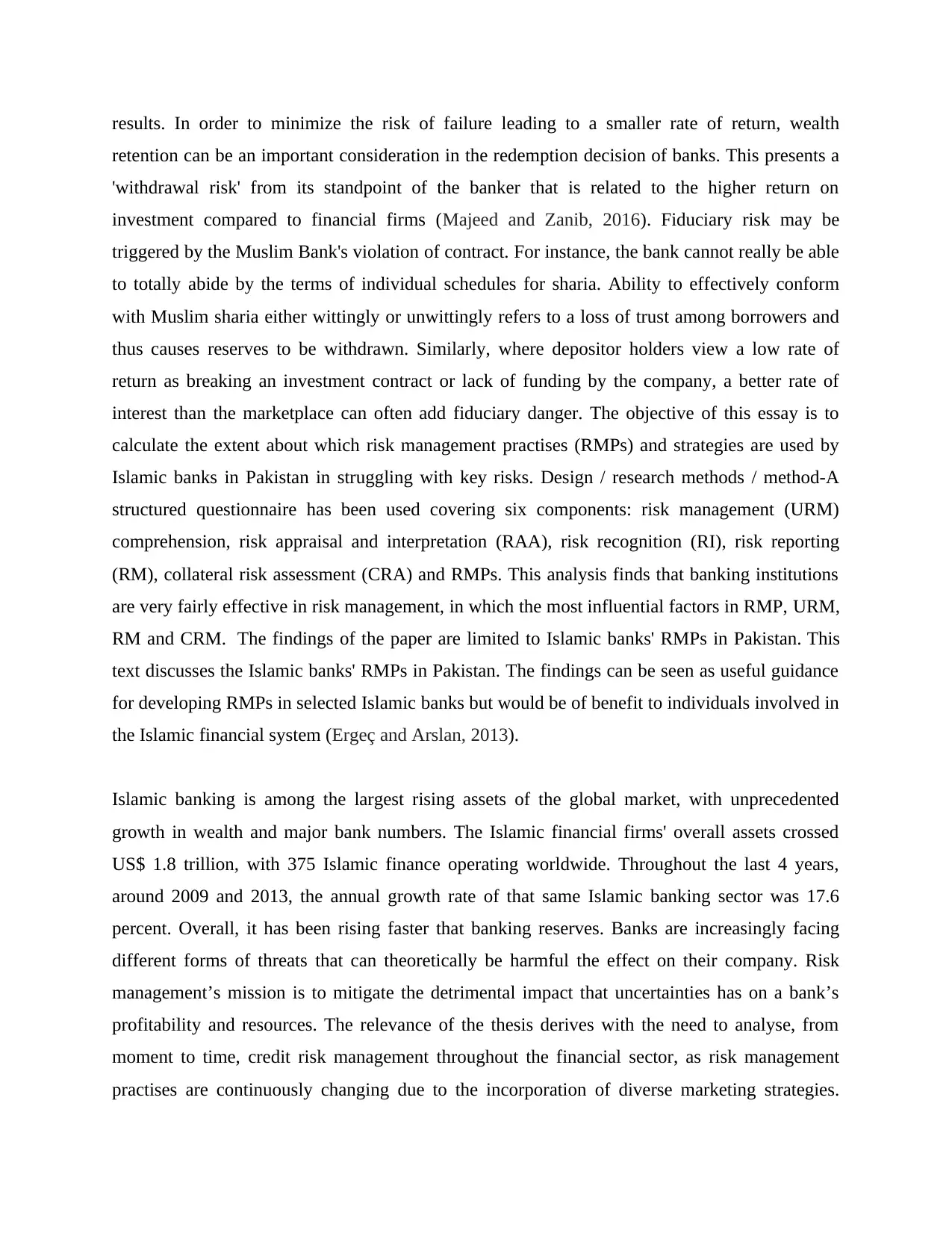
results. In order to minimize the risk of failure leading to a smaller rate of return, wealth
retention can be an important consideration in the redemption decision of banks. This presents a
'withdrawal risk' from its standpoint of the banker that is related to the higher return on
investment compared to financial firms (Majeed and Zanib, 2016). Fiduciary risk may be
triggered by the Muslim Bank's violation of contract. For instance, the bank cannot really be able
to totally abide by the terms of individual schedules for sharia. Ability to effectively conform
with Muslim sharia either wittingly or unwittingly refers to a loss of trust among borrowers and
thus causes reserves to be withdrawn. Similarly, where depositor holders view a low rate of
return as breaking an investment contract or lack of funding by the company, a better rate of
interest than the marketplace can often add fiduciary danger. The objective of this essay is to
calculate the extent about which risk management practises (RMPs) and strategies are used by
Islamic banks in Pakistan in struggling with key risks. Design / research methods / method-A
structured questionnaire has been used covering six components: risk management (URM)
comprehension, risk appraisal and interpretation (RAA), risk recognition (RI), risk reporting
(RM), collateral risk assessment (CRA) and RMPs. This analysis finds that banking institutions
are very fairly effective in risk management, in which the most influential factors in RMP, URM,
RM and CRM. The findings of the paper are limited to Islamic banks' RMPs in Pakistan. This
text discusses the Islamic banks' RMPs in Pakistan. The findings can be seen as useful guidance
for developing RMPs in selected Islamic banks but would be of benefit to individuals involved in
the Islamic financial system (Ergeç and Arslan, 2013).
Islamic banking is among the largest rising assets of the global market, with unprecedented
growth in wealth and major bank numbers. The Islamic financial firms' overall assets crossed
US$ 1.8 trillion, with 375 Islamic finance operating worldwide. Throughout the last 4 years,
around 2009 and 2013, the annual growth rate of that same Islamic banking sector was 17.6
percent. Overall, it has been rising faster that banking reserves. Banks are increasingly facing
different forms of threats that can theoretically be harmful the effect on their company. Risk
management’s mission is to mitigate the detrimental impact that uncertainties has on a bank’s
profitability and resources. The relevance of the thesis derives with the need to analyse, from
moment to time, credit risk management throughout the financial sector, as risk management
practises are continuously changing due to the incorporation of diverse marketing strategies.
retention can be an important consideration in the redemption decision of banks. This presents a
'withdrawal risk' from its standpoint of the banker that is related to the higher return on
investment compared to financial firms (Majeed and Zanib, 2016). Fiduciary risk may be
triggered by the Muslim Bank's violation of contract. For instance, the bank cannot really be able
to totally abide by the terms of individual schedules for sharia. Ability to effectively conform
with Muslim sharia either wittingly or unwittingly refers to a loss of trust among borrowers and
thus causes reserves to be withdrawn. Similarly, where depositor holders view a low rate of
return as breaking an investment contract or lack of funding by the company, a better rate of
interest than the marketplace can often add fiduciary danger. The objective of this essay is to
calculate the extent about which risk management practises (RMPs) and strategies are used by
Islamic banks in Pakistan in struggling with key risks. Design / research methods / method-A
structured questionnaire has been used covering six components: risk management (URM)
comprehension, risk appraisal and interpretation (RAA), risk recognition (RI), risk reporting
(RM), collateral risk assessment (CRA) and RMPs. This analysis finds that banking institutions
are very fairly effective in risk management, in which the most influential factors in RMP, URM,
RM and CRM. The findings of the paper are limited to Islamic banks' RMPs in Pakistan. This
text discusses the Islamic banks' RMPs in Pakistan. The findings can be seen as useful guidance
for developing RMPs in selected Islamic banks but would be of benefit to individuals involved in
the Islamic financial system (Ergeç and Arslan, 2013).
Islamic banking is among the largest rising assets of the global market, with unprecedented
growth in wealth and major bank numbers. The Islamic financial firms' overall assets crossed
US$ 1.8 trillion, with 375 Islamic finance operating worldwide. Throughout the last 4 years,
around 2009 and 2013, the annual growth rate of that same Islamic banking sector was 17.6
percent. Overall, it has been rising faster that banking reserves. Banks are increasingly facing
different forms of threats that can theoretically be harmful the effect on their company. Risk
management’s mission is to mitigate the detrimental impact that uncertainties has on a bank’s
profitability and resources. The relevance of the thesis derives with the need to analyse, from
moment to time, credit risk management throughout the financial sector, as risk management
practises are continuously changing due to the incorporation of diverse marketing strategies.
Paraphrase This Document
Need a fresh take? Get an instant paraphrase of this document with our AI Paraphraser
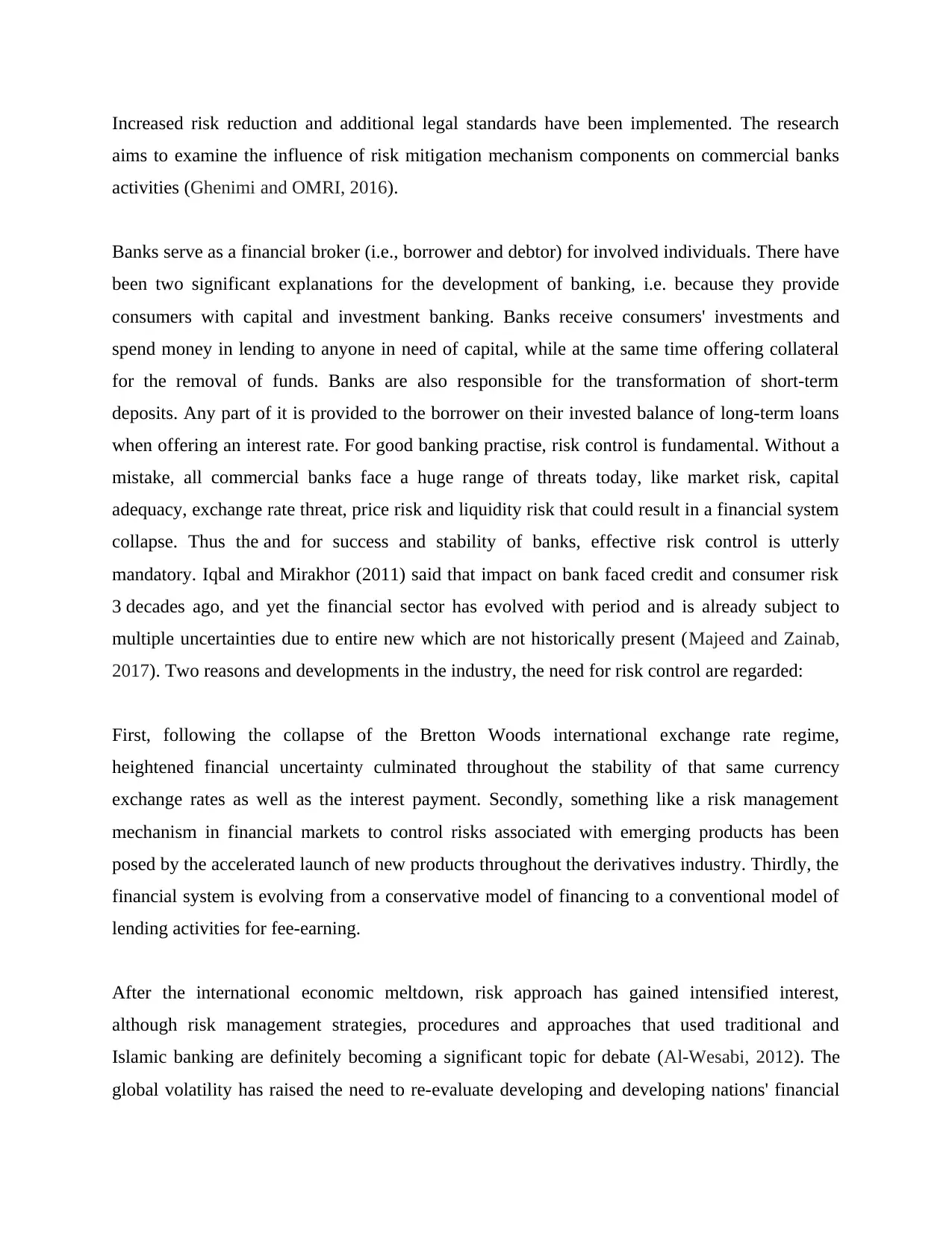
Increased risk reduction and additional legal standards have been implemented. The research
aims to examine the influence of risk mitigation mechanism components on commercial banks
activities (Ghenimi and OMRI, 2016).
Banks serve as a financial broker (i.e., borrower and debtor) for involved individuals. There have
been two significant explanations for the development of banking, i.e. because they provide
consumers with capital and investment banking. Banks receive consumers' investments and
spend money in lending to anyone in need of capital, while at the same time offering collateral
for the removal of funds. Banks are also responsible for the transformation of short-term
deposits. Any part of it is provided to the borrower on their invested balance of long-term loans
when offering an interest rate. For good banking practise, risk control is fundamental. Without a
mistake, all commercial banks face a huge range of threats today, like market risk, capital
adequacy, exchange rate threat, price risk and liquidity risk that could result in a financial system
collapse. Thus the and for success and stability of banks, effective risk control is utterly
mandatory. Iqbal and Mirakhor (2011) said that impact on bank faced credit and consumer risk
3 decades ago, and yet the financial sector has evolved with period and is already subject to
multiple uncertainties due to entire new which are not historically present (Majeed and Zainab,
2017). Two reasons and developments in the industry, the need for risk control are regarded:
First, following the collapse of the Bretton Woods international exchange rate regime,
heightened financial uncertainty culminated throughout the stability of that same currency
exchange rates as well as the interest payment. Secondly, something like a risk management
mechanism in financial markets to control risks associated with emerging products has been
posed by the accelerated launch of new products throughout the derivatives industry. Thirdly, the
financial system is evolving from a conservative model of financing to a conventional model of
lending activities for fee-earning.
After the international economic meltdown, risk approach has gained intensified interest,
although risk management strategies, procedures and approaches that used traditional and
Islamic banking are definitely becoming a significant topic for debate (Al-Wesabi, 2012). The
global volatility has raised the need to re-evaluate developing and developing nations' financial
aims to examine the influence of risk mitigation mechanism components on commercial banks
activities (Ghenimi and OMRI, 2016).
Banks serve as a financial broker (i.e., borrower and debtor) for involved individuals. There have
been two significant explanations for the development of banking, i.e. because they provide
consumers with capital and investment banking. Banks receive consumers' investments and
spend money in lending to anyone in need of capital, while at the same time offering collateral
for the removal of funds. Banks are also responsible for the transformation of short-term
deposits. Any part of it is provided to the borrower on their invested balance of long-term loans
when offering an interest rate. For good banking practise, risk control is fundamental. Without a
mistake, all commercial banks face a huge range of threats today, like market risk, capital
adequacy, exchange rate threat, price risk and liquidity risk that could result in a financial system
collapse. Thus the and for success and stability of banks, effective risk control is utterly
mandatory. Iqbal and Mirakhor (2011) said that impact on bank faced credit and consumer risk
3 decades ago, and yet the financial sector has evolved with period and is already subject to
multiple uncertainties due to entire new which are not historically present (Majeed and Zainab,
2017). Two reasons and developments in the industry, the need for risk control are regarded:
First, following the collapse of the Bretton Woods international exchange rate regime,
heightened financial uncertainty culminated throughout the stability of that same currency
exchange rates as well as the interest payment. Secondly, something like a risk management
mechanism in financial markets to control risks associated with emerging products has been
posed by the accelerated launch of new products throughout the derivatives industry. Thirdly, the
financial system is evolving from a conservative model of financing to a conventional model of
lending activities for fee-earning.
After the international economic meltdown, risk approach has gained intensified interest,
although risk management strategies, procedures and approaches that used traditional and
Islamic banking are definitely becoming a significant topic for debate (Al-Wesabi, 2012). The
global volatility has raised the need to re-evaluate developing and developing nations' financial
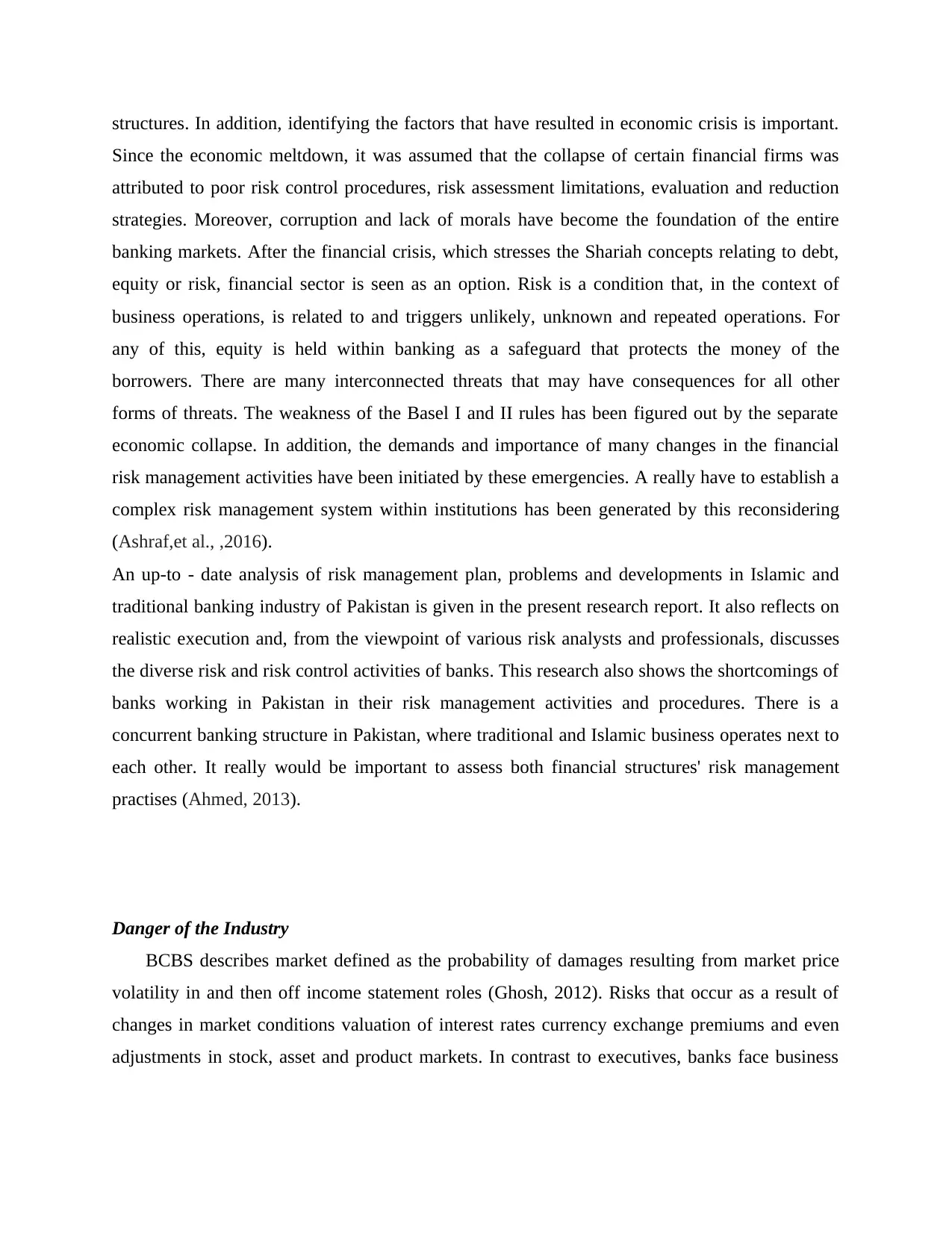
structures. In addition, identifying the factors that have resulted in economic crisis is important.
Since the economic meltdown, it was assumed that the collapse of certain financial firms was
attributed to poor risk control procedures, risk assessment limitations, evaluation and reduction
strategies. Moreover, corruption and lack of morals have become the foundation of the entire
banking markets. After the financial crisis, which stresses the Shariah concepts relating to debt,
equity or risk, financial sector is seen as an option. Risk is a condition that, in the context of
business operations, is related to and triggers unlikely, unknown and repeated operations. For
any of this, equity is held within banking as a safeguard that protects the money of the
borrowers. There are many interconnected threats that may have consequences for all other
forms of threats. The weakness of the Basel I and II rules has been figured out by the separate
economic collapse. In addition, the demands and importance of many changes in the financial
risk management activities have been initiated by these emergencies. A really have to establish a
complex risk management system within institutions has been generated by this reconsidering
(Ashraf,et al., ,2016).
An up-to - date analysis of risk management plan, problems and developments in Islamic and
traditional banking industry of Pakistan is given in the present research report. It also reflects on
realistic execution and, from the viewpoint of various risk analysts and professionals, discusses
the diverse risk and risk control activities of banks. This research also shows the shortcomings of
banks working in Pakistan in their risk management activities and procedures. There is a
concurrent banking structure in Pakistan, where traditional and Islamic business operates next to
each other. It really would be important to assess both financial structures' risk management
practises (Ahmed, 2013).
Danger of the Industry
BCBS describes market defined as the probability of damages resulting from market price
volatility in and then off income statement roles (Ghosh, 2012). Risks that occur as a result of
changes in market conditions valuation of interest rates currency exchange premiums and even
adjustments in stock, asset and product markets. In contrast to executives, banks face business
Since the economic meltdown, it was assumed that the collapse of certain financial firms was
attributed to poor risk control procedures, risk assessment limitations, evaluation and reduction
strategies. Moreover, corruption and lack of morals have become the foundation of the entire
banking markets. After the financial crisis, which stresses the Shariah concepts relating to debt,
equity or risk, financial sector is seen as an option. Risk is a condition that, in the context of
business operations, is related to and triggers unlikely, unknown and repeated operations. For
any of this, equity is held within banking as a safeguard that protects the money of the
borrowers. There are many interconnected threats that may have consequences for all other
forms of threats. The weakness of the Basel I and II rules has been figured out by the separate
economic collapse. In addition, the demands and importance of many changes in the financial
risk management activities have been initiated by these emergencies. A really have to establish a
complex risk management system within institutions has been generated by this reconsidering
(Ashraf,et al., ,2016).
An up-to - date analysis of risk management plan, problems and developments in Islamic and
traditional banking industry of Pakistan is given in the present research report. It also reflects on
realistic execution and, from the viewpoint of various risk analysts and professionals, discusses
the diverse risk and risk control activities of banks. This research also shows the shortcomings of
banks working in Pakistan in their risk management activities and procedures. There is a
concurrent banking structure in Pakistan, where traditional and Islamic business operates next to
each other. It really would be important to assess both financial structures' risk management
practises (Ahmed, 2013).
Danger of the Industry
BCBS describes market defined as the probability of damages resulting from market price
volatility in and then off income statement roles (Ghosh, 2012). Risks that occur as a result of
changes in market conditions valuation of interest rates currency exchange premiums and even
adjustments in stock, asset and product markets. In contrast to executives, banks face business
⊘ This is a preview!⊘
Do you want full access?
Subscribe today to unlock all pages.

Trusted by 1+ million students worldwide
1 out of 69
Related Documents
Your All-in-One AI-Powered Toolkit for Academic Success.
+13062052269
info@desklib.com
Available 24*7 on WhatsApp / Email
![[object Object]](/_next/static/media/star-bottom.7253800d.svg)
Unlock your academic potential
Copyright © 2020–2025 A2Z Services. All Rights Reserved. Developed and managed by ZUCOL.





